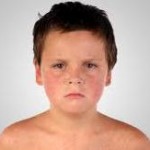Rubella Symptoms in Children
 Rubella is another form of viral infection also called German measles or 3 day measles. The term German has no connection with the country but may have come from French term ‘germain’ meaning similar. When a child contracts rubella he has mild fever between 99 to 100°F which lasts for about two days. Glands on neck or behind the ears get swollen. Generally on the third day rash appears at the hairline of the child and spreads downwards. As the rash moves from face to the body it starts to clear from the face. The rash is in the form of pink or red spots which being close to each other appear as coloured patches on face or body. The rash fades away in five days at places shedding from body.
Rubella is another form of viral infection also called German measles or 3 day measles. The term German has no connection with the country but may have come from French term ‘germain’ meaning similar. When a child contracts rubella he has mild fever between 99 to 100°F which lasts for about two days. Glands on neck or behind the ears get swollen. Generally on the third day rash appears at the hairline of the child and spreads downwards. As the rash moves from face to the body it starts to clear from the face. The rash is in the form of pink or red spots which being close to each other appear as coloured patches on face or body. The rash fades away in five days at places shedding from body.
Signs and symptoms of rubella in children
Rubella is associated with other symptoms too. These are:
- The child may develop a milder form of conjunctivitis.
- The child may have stuffy or running nose.
- Lymph glands of the child may get swollen.
- The child may have pain in joints and body especially in testicles of male child.
In case the pregnant woman gets infected with rubella this may have serious consequences on her developing foetus. In such an event the child may develop growth retardation, his heart may malfunction, he may have problem with eyes, ears, brain liver and spleen.
Rubella is caused by a virus which affects lymph glands and skin of the child and is caused by the virus also called rubella. This virus is found in throat, blood and stool of the person infected. In the living child the virus enters his body through breathing process or mouth. In case of child in mother’s womb it can enter through blood if the mother gets infected. Though not serious in living kids but the dangers in case of unborn child are many folds.
The rash takes 4 to 5 days to fully clear but 3 days is the most common clearing period, this is the reason of this disease also being called 3 days measles. The virus travels from a person to person through virus trapped in droplets which spread in atmosphere by cough or sneezing of the affected person. The affected person remains contagious one week before rash appears and one week after it fades. The incubation period is 14 to 21 days.
Vaccination
A vaccine against rubella was made available in the year 1969. Before invention and use of this vaccine there were epidemics in many parts of the world every 6 to nine years and children between the ages of 5 to 9 were the most affected. After regular administration of vaccine the instances have gone down to 10%. As this can also affect adults mothers of child bearing age needs special attention.
Very effective vaccine is available and is administered to the children between the ages of 12 to 15 months of age. This is a part of immunization programme followed worldwide and called MMR dose, which means measles-mumps-rubella immunization. A booster or repeat dose is given between the ages of 4 to 6. It is not advisable to be given to a pregnant woman or a woman should not get pregnant within 3 months of administration of the vaccine.
Being a viral infected disease antibiotics are not effective. The disease has to take its own time to heal but the child needs to be made comfortable. To avoid discomfort due to fever he may be given an advised dose of medicine. Under no circumstances aspirin should be administered to the child as the child suffering from viral attack may develop Reye’s syndrome which may be fatal.